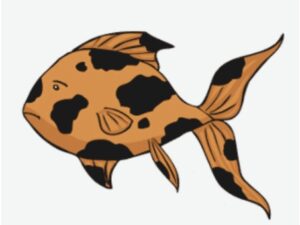The Moonlight Gourami, also known as the Moonbeam Gourami, is native to Indochina. It is a popular aquarium fish introduced to many areas outside its natural range.
This fish is native to the slow-running waters of Indochina and is found in Thailand, Malaysia, and Indonesia. It prefers habitats with dense vegetation and submerged roots or branches.
It comes from the broader gourami family, which contains more than 90 species. The Moonlight Gourami is distinguished by its striped coloration and long fins.
The Moonlight Gourami is famous for both novice and experienced aquarium enthusiasts. It is relatively easy to care for and can be kept in many tank conditions.
This article will take a closer look at the Moonlight Gourami, including its appearance, diet, and care requirements.
So without further ado, let’s learn all about the Moonlight Gourami!
Table of Contents
- Moonlight Gourami Species Summary
- Moonlight Gourami Care Guide
- Moonlight Gourami Food & Diet
- Moonlight Gourami Diet Foods To Avoid
- The Importance Of A Healthy Diet
- Moonlight Gourami Feeding Schedule
- Moonlight Gourami Tank Size
- Filtration
- Substrate
- Water Parameters
- Plants
- Heating
- Lighting
- Fertilizers
- Co2 Systems
- Water Conditioners
- Decorations
- Other Tank Accessories
- Water Changes
- Cleaning The Tank
- Cleaning The Filter
- Testing The Water
- Moonlight Gourami Common Possible Diseases
- Signs That Your Moonlight Gourami Is Sick
- Moonlight Gourami Preventing Diseases
- Moonlight Gourami Treatment And Medications Of Diseases
- How To Choose A Healthy Moonlight Gourami
- Moonlight Gourami Tank Mates
- Moonlight Gourami Fish To Avoid
- Advantages Of Having Moonlight Gourami In Your Tank
- Disadvantages Of Having Moonlight Gourami In Your Tank
- Wrapping Up
Moonlight Gourami Species Summary
| Scientific name: | Trichopodus microlepis |
| Common names: | Moonbeam gourami |
| Family: | Osphronemidae (gourami family) |
| Color: | Silver with green iridescence |
| Origin: | Indochina (Thailand, Indonesia) |
| Adult size: | Up to 6 inches |
| Life expectancy: | Up to 6 years |
| Habitat: | Densely vegetated, slow-moving waters |
| Minimum tank size: | 20 gallons |
| Temperature range: | 77° to 86° Fahrenheit |
| pH range: | 6.5 to 7.0 |
| Water type: | Freshwater |
| Water hardness: | 5 to 15 dGH |
| Activity Level: | Moderate |
| Sociability: | Peaceful, can be kept with other peaceful fish |
| Tankmates: | Other peaceful fish |
| Gender Differences: | Males have longer fins |
| Care Level: | Moderate |
| Temperament: | Peaceful |
| Compatibility: | Peaceful, medium-sized species |
| Breeding method: | Egg-laying |
| Ease of breeding: | Moderate |
| Diet: | Omnivorous, eat a variety of living, frozen, and dried foods |
| Feeding Frequency: | 1 to 2 times per day |
The Moonlight Gourami is a freshwater labyrinth fish, which means it has a unique organ that allows it to breathe air. This is an adaptation to living in waters with low dissolved oxygen levels.
Gouramis are peaceful fish that can be kept with other peaceful species. However, they are known to be territorial with their kind and may fight with other gouramis of the same species.
The Moonlight Gourami is a popular aquarium fish because it is relatively easy to care for and has a beautiful iridescent coloration. They are also hardy fish that can tolerate many tank conditions.
The cost of Moonlight Gourami ranges from $5 to $10. But, the price may be higher for rarer color morphs.
Moonlight Gourami Appearance
Moonlight Gouramis are silver with a green iridescence. They have three vertical stripes that run along their body from head to tail. The middle stripe is usually the darkest, while the two outer stripes are lighter.
The fins of males are often longer and more elaborate than those of females. Females also tend to have a rounder body shape.
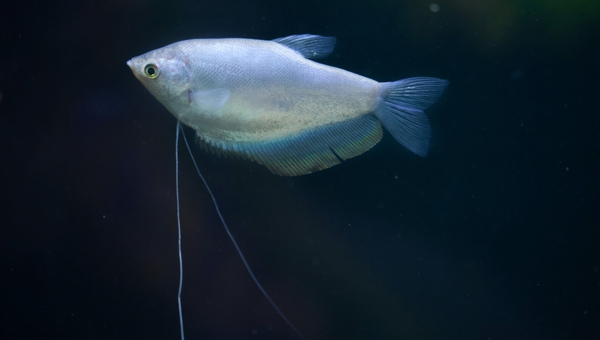
Males are also typically larger than females, as we mentioned before. The eyes of Moonlight Gourami are red, which sets them apart from other gourami species.
Several color morphs of the Moonlight Gourami are available in the aquarium trade. These include albino, green, blue, and leucistic (lacks dark pigmentation).
The most common color morph is the albino, which is entirely white with red eyes. But the green and blue morphs are becoming more popular as well.
They have fragile, almost transparent fins that can easily damage. So, providing them with a tank with plenty of hiding places and soft, floating plants is essential.
Moonlight Gourami Size & Growth Rate
The size of the full-grown Moonlight Gourami depends on the sex of the fish. Males can reach up to six inches, while females are typically smaller at four inches.
The growth rate of Moonlight Gourami is moderate. They will reach their full size in about 12 to 18 months.
Moonlight Gourami Lifespan
The lifespan of Moonlight Gourami is typically four years, but it can vary depending on the quality of care they receive.
However, some individuals have been known to live up to 6 years in captivity.
Moonlight Gourami Behavior & Temperament
The Moonlight Gourami is a peaceful fish and is an excellent addition to most community tanks. They are not known to be aggressive and will get along with most other fish. They are also known to be good parents and will often care for their young.
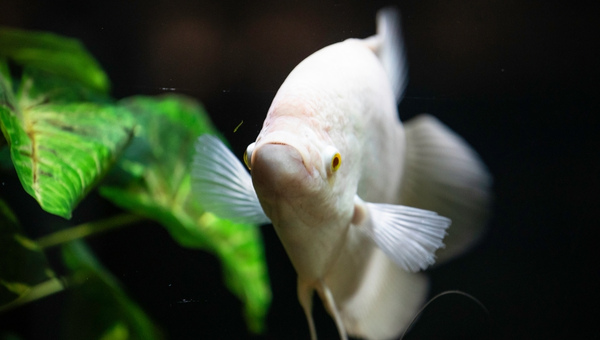
This fish is usually passive as well as social. It is known to be a good community fish and will often get along with other fish in the tank. They are not known to be aggressive and usually only become aggressive if they feel threatened.
This fish is usually most active during the evening hours and will often be seen swimming at the top of the tank. They are known to be good jumpers, so having a lid on your tank is essential.
They also get along with most other species that display the same behaviors. So, if you want a community tank with a lot of action, the Moonlight Gourami is a good choice.
Moonlight Gourami Breeding
To breed Moonlight Gouramis, you will need the following:
- A breeding tank: The breeding tank should have at least 10 gallons and a sponge filter.
- Live plants: The live plants will provide hiding places for the fry (baby fish).
- Spawning mops or java moss: The spawning mops or java moss will provide a place for the female to lay her eggs.
- A group of Moonlight Gouramis: You will need at least one male and one female, but it is best to have several of each. The more fish you have, the better your chances of getting a successful spawn.
- Live foods: You must feed your fish live foods, such as brine shrimp, to entice them to spawn.
Once the breeding tank is set up, you must wait for the fish to spawn. The female will lay her eggs on the plants or mops, and the male will fertilize them. Once the eggs are fertilized, they will hatch in about 24 hours.
The fry (baby fish) will be tiny and must be fed small live foods, such as brine shrimp or micro worms. The fry will proliferate and be ready to move to a larger tank in about six weeks.
They are peaceful fish that makes a great addition to any community tank.
They are relatively easy to care for and are not picky eaters. They are also easy to breed and do an excellent project for beginner aquarists.
Moonlight Gourami Care Guide
The Moonlight Gourami is a relatively easy fish to care for and can be a good choice for beginner aquarists. They tolerate many water conditions and are not particularly messy fish.
They are not particularly demanding of the water quality in their tank. However, keeping the water clean is always a good idea.
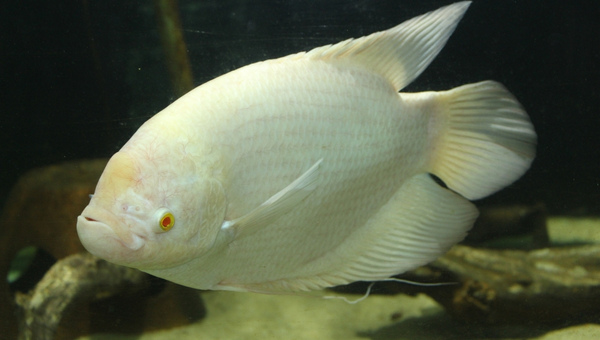
This will help prevent the spread of disease and make your fish happier and healthier.
We recommend performing a 25% water change at least once weekly or more often if you have a heavily stocked tank.
They are not particularly fussy eaters and will accept most types of food. They are omnivores, which means they will eat both plants and animals.
Feeding them various foods is a good idea to ensure they get all the necessary nutrients.
They are social fish that should be kept in groups of at least three individuals. They are known to be territorial with their kind, so providing them with plenty of space is essential.
Breeding them in captivity is not particularly difficult, but it requires patience.
We will discuss everything you need about caring, including their tank requirements, diet, and breeding.
Moonlight Gourami Food & Diet
Moonlight Gouramis are omnivores and should be provided with a varied diet. Some good food options include:
- Brine shrimp
- Bloodworms
- Daphnia
- Tubifex worms
- live plants
It is essential to provide a varied diet to ensure your fish get all the nutrients they need. You can also supplement their diet with flakes or pellets.
Moonlight Gourami Diet Foods To Avoid
There are a few diet foods that you should avoid feeding your Moonlight Gourami.
These include:
- Raw meat: Raw meat can contain bacteria that can harm your fish.
- Insects: Insects can carry diseases that can harm your fish.
- Plants: Some plants can be toxic to fish. Be sure to research any plants before adding them to your tank.
- Fish food past its expiration date: Expired fish food can contain harmful bacteria.
The Importance Of A Healthy Diet
A healthy diet is essential for a variety of reasons.
Some of these reasons include the following:
- A healthy diet can help prevent disease.
- A healthy diet can help your fish grow and develop properly.
- A healthy diet can help your fish stay active and playful.
- A healthy diet can help your fish live a long and healthy life.
Moonlight Gourami Feeding Schedule
When feeding your Moonlight Gourami, it is essential to stick to a regular feeding schedule.
Some things to keep in mind include the following:
- Feed your fish twice a day.
- Give them enough food to eat in 2-3 minutes.
- Remove any uneaten food from the tank.
- Do not overfeed your fish.
Moonlight Gourami Tank Size
They should be kept in a tank that is at least 20 gallons. But we recommend a larger tank if you keep them in a group.
A 20-gallon tank will comfortably house three Moonlight Gouramis. But, if you are keeping them in a group of 5 or more, you will need a 30-gallon tank.
Filtration
They are not particularly sensitive to changes in water quality, but it’s always a good idea to keep the water as clean as possible.
We recommend using a filter rated for a tank of at least twice the size of your tank. So, if you have a 20-gallon tank, you should use a filter rated for at least a 40-gallon tank.
You can also use an aquarium sponge filter if you have a smaller tank. A good filter will help to keep the water clean and will also help to oxygenate the water.
Some recommended filters for Moonlight Gouramis are:
- The Aqua Clear 20 Power Filter
- The Marineland Penguin Power Filter
- The Fluval 206 Canister Filter
Substrate
The substrate is the material used to cover the bottom of the tank. It can be made from various materials, such as sand, gravel, or rocks.
Some recommended substrates for Moonlight Gouramis are:
- The Eco-Complete Planted Aquarium Substrate
- The Fluval Aquatic Plant Soil
- The Miracle-Gro Nature’s Care Aqua Coir
Water Parameters
They tolerate many water conditions but prefer slightly alkaline water with a pH of 6.5 to 8.0. The water temperature should be kept between 77° to 86°Fahrenheit.
The water hardness should be between 5 to 15 dGH. The specific gravity should be between 1.020 to 1.025.
They are not particularly sensitive to changes in water quality, but it’s always a good idea to keep the water as clean as possible.
You can use a water test kit to test your tank’s water quality and ensure it falls within the acceptable range.
Plants
They are not particularly fussy when it comes to plants. They will do well in a tank with live plants or fake plants.
Some recommended plants for Moonlight Gouramis are:
- The Java Fern
- The Hornwort
- The Anacharis
- The Water Wisteria
Heating
The water temperature should be kept between 77° to 86° Fahrenheit. We recommend using an aquarium heater to maintain a consistent water temperature.
Some recommended heaters for Moonlight Gouramis are:
- The Tetra submersible aquarium heater: Tanks up to 20 gallons
- The Fluval Eheim Jager Aquarium Heater: Tanks up to 60 gallons
- The Zacro Glass Aquarium Heater: Tanks up to 80 gallons
Lighting
They do not require special lighting and will do well in a tank with standard aquarium lighting.
Some recommended lights for Moonlight Gouramis are:
- The Fluval Sea CP1 Power Compact Aquarium Lighting
- The Marineland LED Aquarium Lighting
- The Zoo Med Aqua Sun UVB Fluorescent Bulb
- The Aqueon LED Aquarium Lighting
Fertilizers
Plants need nutrients to grow and thrive. These nutrients can be found in the form of fertilizers. Fertilizers can be added to the water or applied directly to the plants.
Some recommended fertilizers for Moonlight Gouramis are:
- The Seachem Flourish Tabs
- The API Leaf Zone Plant Food
- The Nutrafin Plant-Gro Fertilizer
Co2 Systems
Plants need carbon dioxide (CO2) to grow. A CO2 system can provide plants with the CO2 they need.
Some recommended CO2 systems for Moonlight Gouramis are:
- The Fluval EVO CO2 Kit
- The Aquarium Plant Food CO2 System
- The AquaVita Aquarium CO2 System
Water Conditioners
Water conditioners are used to remove impurities from the water. They can also be used to adjust the pH of the water.
Some recommended water conditioners for Moonlight Gouramis are:
- The Seachem Prime Water Conditioner
- The API Stress Coat Water Conditioner
- The Aqua Safe Water Conditioner
Decorations
Decorations can be used to add color and interest to the tank. They can also provide hiding places for fish.
Some recommended decorations for Moonlight Gouramis are:
- The Penn-Plax Aquarium Decor
- The Marina Decorations
- The Tetra Aquarium Decorations
Other Tank Accessories
There are a few other things that you will need for your tanks, such as a heater and a filter.
Some recommended tank accessories for Moonlight Gouramis are:
- The Aqua Culture 10-gallon fishnet
- The Fluval Edge algae magnet
- The API Freshwater Master Test Kit
Water Changes
It is essential to do regular water changes to keep the water clean and the fish healthy. Water changes also help to remove any build-up of toxins in the water.
A good rule of thumb is to do a water change of 20-25% weekly.
To change the water, you will need the following:
- A siphon: This is used to remove water from the tank.
- A clean bucket: This is used to hold the water that has been removed from the tank.
- Freshwater aquarium salt: This replaces the minerals removed during a water change.
The steps to changing the water are:
- Use the siphon to remove water from the tank and into the bucket.
- Add the appropriate amount of freshwater aquarium salt to the bucket.
- Use a clean cup or pitcher to slowly add the new water to the tank, being careful not to disturb the substrate too much.
- Discard the old water that was removed from the tank.
- Repeat these steps once a week.
Cleaning The Tank
It is essential to keep the tank clean to provide a healthy environment for the fish.
Cleaning the tank also helps to prevent algae growth.
To clean the tank, you will need the following:
- An algae scrubber: This is used to remove algae from the glass.
- A sponge: This is used to wipe down the inside of the tank.
- A gravel vacuum: This is used to remove debris and waste from the substrate.
The steps to cleaning the tank are as follows:
- Use the algae scrubber to remove algae from the glass.
- Use the sponge to wipe down the inside of the tank.
- Use the gravel vacuum to remove debris and waste from the substrate.
- Rinse all the equipment used in clean water before putting it back into the tank.
- Repeat these steps every 2-4 weeks.
Cleaning The Filter
It is essential to keep the filter clean to provide a healthy environment for the fish.
Cleaning the filter also helps to prevent algae growth.
To clean the filter, you will need the following:
- A sponge is used to wipe down the outside of the filter.
- A toothbrush: This is used to clean the intake and output tubes.
- Filter media: This replaces the old media removed from the filter.
The steps to cleaning the filter are as follows:
- Use the sponge to wipe down the outside of the filter.
- Use the toothbrush to clean the intake and output tubes.
- Remove the old media from the filter and replace it with new media.
- Rinse all the equipment used in clean water before putting it back into the tank.
- Repeat these steps every 2-4 weeks.
Testing The Water
It is essential to test the water regularly to keep the fish healthy.
Testing the water helps ensure that the levels of ammonia, nitrites, and nitrates are safe for the fish.
To test the water, you will need the following:
- A test kit tests the ammonia, nitrites, and nitrates levels in the water.
The steps to testing the water are as follows:
- Fill a clean cup with water from the tank.
- The kit will test the water’s ammonia, nitrites, and nitrates levels.
- If any of these chemicals are too high, take steps to correct the issue.
- Repeat these steps every 2-4 weeks.
Moonlight Gourami Common Possible Diseases
There are a few diseases that are common in Moonlight Gouramis.
Some of these diseases include:
- Ich
- Hole-in-the-head disease
- Fin rot
- Erosion of the Lateral Line
Signs That Your Moonlight Gourami Is Sick
There are a few signs that you can look for that will indicate that your Moonlight Gourami is sick. Some of these signs include:
- Loss of appetite: If your fish stops eating, it could signify something is wrong.
- Loss of coloration: If your fish’s colors start to fade, it could be a sign of disease.
- Clamped fins: If your fish’s fins are held close to the body, it could be a sign of stress or disease.
- Lethargy: If your fish constantly lies at the bottom of the tank, it could be a sign of disease.
- Flashing: If your fish constantly rub itself against objects in the tank, it could be a sign of parasites.
- Odd behavior: If you notice any changes in your fish’s behavior, it could indicate something is wrong.
If you notice any of these signs, it is essential to treat the issue immediately. The sooner you catch and treat a disease, the better the chances are of your fish fully recovering.
Moonlight Gourami Preventing Diseases
There are a few things that you can do to prevent diseases in Moonlight Gouramis.
Some of these things include:
- Quarantine new fish: When you add new fish to your tank, it is essential to quarantine them for at least two weeks. This will help ensure they are not carrying any diseases that could infect the other fish in your tank.
- Keep your tank clean: A clean tank is essential for preventing diseases. Be sure to do regular water changes and clean the filter regularly.
- Provide a healthy diet: A healthy diet will help ensure your fish are less susceptible to diseases. Be sure to provide a varied diet that is rich in nutrients.
- Avoid overstocking: Overstocking your tank can lead to poor water quality, increasing disease risk. Be sure not to overcrowd your tank.
- Keep an eye on your fish: It is essential to monitor your fish regularly. This will help you spot any signs of disease early on and take steps to treat the issue.
Moonlight Gourami Treatment And Medications Of Diseases
There are various medications that can be used to treat diseases in Moonlight Gouramis.
Some of these medications include:
- Antibiotics: Antibiotics can be used to treat bacterial infections.
- Antifungals: Antifungals can be used to treat fungal infections.
- Parasiticides: Parasiticides can be used to treat parasitic infections.
- Stress Coat: A stress Coat can help reduce stress in fish.
- Melafix: Melafix is an all-natural treatment that can be used to treat a variety of diseases.
It is essential to consult with a veterinarian before using any medications. They can help you choose the best medication for your fish and provide dosage information.
How To Choose A Healthy Moonlight Gourami
When choosing Moonlight Gourami, it is essential to choose a healthy fish.
Some things to look for include the following:
- Bright colors: A healthy fish will have bright colors.
- Clear eyes: Healthy fish will have clear eyes.
- Smooth scales: Healthy fish will have smooth scales.
- Dynamic behavior: Healthy fish will be active and swim around the tank.
- Good appetite: Healthy fish will have a good appetite.
Moonlight Gourami Tank Mates
Moonlight Gouramis feel most comfortable in a tank when they have other fish to socialize with. However, choosing suitable tank mates for your fish is essential.
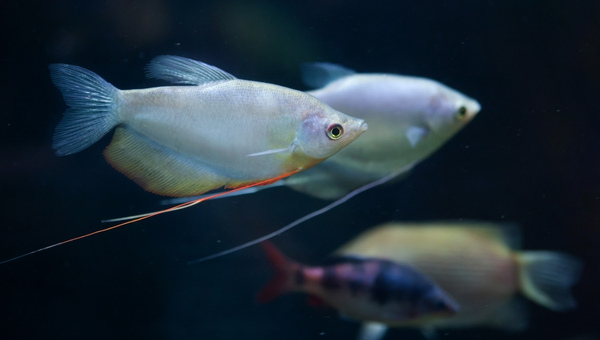
They get along well with medium-size non-aggressive fish, like:
- Corydoras
- Freshwater Angelfish
- Guppies
- Mollies
- Platies
- Swordtails
- Tetras
- Amano Shrimp
Invertebrates like snails and crabs are also good tank mates for this fish.
It is essential to avoid putting them with fish that are aggressive or larger than them, as this can cause stress and make them more likely to become aggressive.
Also Read: Neon Tetra Care Guide: Appearance, Breeding & All
Moonlight Gourami Fish To Avoid
These fish are not recommended because they are either aggressive or too large. Both of these things can cause stress for your Moonlight Gourami, which can lead to health problems.
Advantages Of Having Moonlight Gourami In Your Tank
The first advantage is that they are lovely fish. They have a silver bodies with iridescent blue stripes running along their sides. The Moonlight Gourami is one of the most popular freshwater aquarium fish.
Another great thing about them is that they are very peaceful fish. They get along well with other peaceful fish and can be kept with invertebrates.
They are also easy to care for. They are not picky eaters and can adapt to various water conditions.
Breeding Moonlight Gouramis are also relatively easy. The fry (baby fish) is easy to care for and proliferates.
Disadvantages Of Having Moonlight Gourami In Your Tank
The first disadvantage of having Moonlight Gouramis in your tank is that they are sensitive to changes in water conditions. They should not be kept in a tank with aggressive fish, which can cause stress.
Another disadvantage is that they are not compatible with all types of filtration. They should not be kept in a tank with a power filter, as the strong currents can stress them out.
They are also susceptible to diseases, such as ich and velvet. These diseases are often fatal in Moonlight Gouramis, so it is important to quarantine new fish before adding them to your tank.
Wrapping Up
As you can see, having Moonlight Gouramis in your tank has both advantages and disadvantages. However, providing them with a peaceful environment and stable water conditions makes them a great addition to any community tank.
They are also relatively easy to care for and are not picky eaters. They are also easy to breed and do an excellent project for beginner aquarists.
I hope this article has helped you decide whether or not Moonlight Gouramis are the right fish for your tank.



